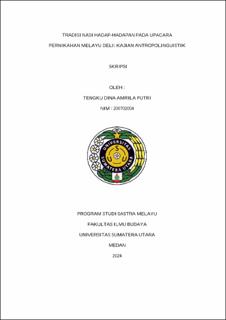Tradisi Nasi Hadap-Hadapan pada Upacara Pernikahan Melayu Deli: Kajian Antropolinguistik
Tradition of Facing Rice at Ceremonies Deli Malay Marriage: An Anthropolinguistic Study

Date
2024Author
Putri, Tengku Dina Amrila
Advisor(s)
Baharuddin
Nasution, Arie Azhari
Metadata
Show full item recordAbstract
This research aims to explain performance, indexicality, participation. the tradition
of the facing-face rice ceremony at weddings in the Deli Malay community at the
Deli Raya Complex, JL Taska Ujung, Medan Deli District, Titipapan Subdistrict.
This research uses anthropolinguistic theory with a focus on Duranti studies. The
research method used is a qualitative descriptive method in order to present and
analyze data systematically, factually and accurately. The data collection used was
the listening listening method, which was carried out using face-to-face techniques,
recording techniques and note-taking techniques. The results of the research showed
that the performance or appearance in the tradition of rice face to face was delivered
by Mak Inang who had a conversation, then sat down. The bride and groom are side
by side, the wife is on the husband's left, the wife must sit on her knees and the
husband sits cross- legged. The meaning is polite or respectful towards the husband
and next to the groom is the bride's family and their seating shape is rectangular and
in the middle various typical Malay food menus are served. The series of events that
will be held include the opening, presenting the bride and groom, fighting over the
chicken in the rice, toasting, drinking cross toasts, inviting the audience to taste the
dishes. Indexicality or tools used with existing objects/ signs in the form of bridal
clothes brackets/bay belanga cloth, tengkolok, edit, keris, tepak, betel, areca nut,
gambier. Participation or parties involved are the bride and groom, the wet nurse, the
guests and the bridal midwife
Collections
- Undergraduate Theses [222]
